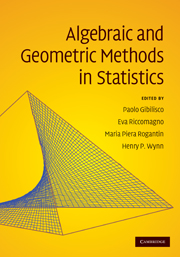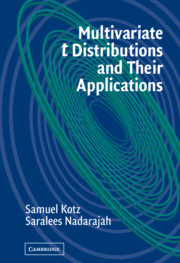Refine search
Actions for selected content:
2348 results in Statistical theory and methods

Algebraic and Geometric Methods in Statistics
-
- Published online:
- 27 May 2010
- Print publication:
- 22 October 2009

Multivariate T-Distributions and Their Applications
-
- Published online:
- 04 May 2010
- Print publication:
- 16 February 2004
Subject index
-
- Book:
- Bayesian Nonparametrics
- Published online:
- 06 January 2011
- Print publication:
- 12 April 2010, pp 297-299
-
- Chapter
- Export citation
4 - Further models and applications
-
-
- Book:
- Bayesian Nonparametrics
- Published online:
- 06 January 2011
- Print publication:
- 12 April 2010, pp 137-157
-
- Chapter
- Export citation
List of contributors
-
- Book:
- Bayesian Nonparametrics
- Published online:
- 06 January 2011
- Print publication:
- 12 April 2010, pp viii-viii
-
- Chapter
- Export citation
6 - Computational issues arising in Bayesian nonparametric hierarchical models
-
-
- Book:
- Bayesian Nonparametrics
- Published online:
- 06 January 2011
- Print publication:
- 12 April 2010, pp 208-222
-
- Chapter
- Export citation
3 - Models beyond the Dirichlet process
-
-
- Book:
- Bayesian Nonparametrics
- Published online:
- 06 January 2011
- Print publication:
- 12 April 2010, pp 80-136
-
- Chapter
- Export citation
1 - Bayesian nonparametric methods: motivation and ideas
-
-
- Book:
- Bayesian Nonparametrics
- Published online:
- 06 January 2011
- Print publication:
- 12 April 2010, pp 22-34
-
- Chapter
- Export citation
An invitation to Bayesian nonparametrics
-
-
- Book:
- Bayesian Nonparametrics
- Published online:
- 06 January 2011
- Print publication:
- 12 April 2010, pp 1-21
-
- Chapter
- Export citation
Frontmatter
-
- Book:
- Bayesian Nonparametrics
- Published online:
- 06 January 2011
- Print publication:
- 12 April 2010, pp i-iv
-
- Chapter
- Export citation
7 - Nonparametric Bayes applications to biostatistics
-
-
- Book:
- Bayesian Nonparametrics
- Published online:
- 06 January 2011
- Print publication:
- 12 April 2010, pp 223-273
-
- Chapter
- Export citation
Contents
-
- Book:
- Bayesian Nonparametrics
- Published online:
- 06 January 2011
- Print publication:
- 12 April 2010, pp v-vii
-
- Chapter
- Export citation
Author index
-
- Book:
- Bayesian Nonparametrics
- Published online:
- 06 January 2011
- Print publication:
- 12 April 2010, pp 292-296
-
- Chapter
- Export citation
8 - More nonparametric Bayesian models for biostatistics
-
-
- Book:
- Bayesian Nonparametrics
- Published online:
- 06 January 2011
- Print publication:
- 12 April 2010, pp 274-291
-
- Chapter
- Export citation
2 - The Dirichlet process, related priors and posterior asymptotics
-
-
- Book:
- Bayesian Nonparametrics
- Published online:
- 06 January 2011
- Print publication:
- 12 April 2010, pp 35-79
-
- Chapter
- Export citation
5 - Hierarchical Bayesian nonparametric models with applications
-
-
- Book:
- Bayesian Nonparametrics
- Published online:
- 06 January 2011
- Print publication:
- 12 April 2010, pp 158-207
-
- Chapter
- Export citation
Contents
-
- Book:
- Modeling Ordered Choices
- Published online:
- 05 June 2012
- Print publication:
- 08 April 2010, pp v-viii
-
- Chapter
- Export citation
List of tables
-
- Book:
- Modeling Ordered Choices
- Published online:
- 05 June 2012
- Print publication:
- 08 April 2010, pp ix-x
-
- Chapter
- Export citation
Frontmatter
-
- Book:
- Modeling Ordered Choices
- Published online:
- 05 June 2012
- Print publication:
- 08 April 2010, pp i-iv
-
- Chapter
- Export citation
1 - Introduction: random utility and ordered choice models
-
- Book:
- Modeling Ordered Choices
- Published online:
- 05 June 2012
- Print publication:
- 08 April 2010, pp 1-8
-
- Chapter
- Export citation
